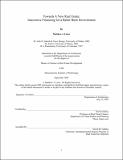| dc.contributor.advisor | David Geltner. | en_US |
| dc.contributor.author | Lister, Matthew J. (Matthew James) | en_US |
| dc.contributor.other | Massachusetts Institute of Technology. Dept. of Architecture. | en_US |
| dc.date.accessioned | 2008-09-02T17:51:53Z | |
| dc.date.available | 2008-09-02T17:51:53Z | |
| dc.date.issued | 2007 | en_US |
| dc.identifier.uri | http://hdl.handle.net/1721.1/42031 | |
| dc.description | Thesis (S.M. in Real Estate Development)--Massachusetts Institute of Technology, Dept. of Architecture, 2007. | en_US |
| dc.description | This electronic version was submitted by the student author. The certified thesis is available in the Institute Archives and Special Collections. | en_US |
| dc.description | "September 2007." | en_US |
| dc.description | Includes bibliographical references (leaves 53-55). | en_US |
| dc.description.abstract | The real estate industry has evolved significantly over the last century. This evolution has enabled the rise of real estate to be one of the largest and most important asset classes in American investment. Yet this evolution has also produced a system of development that has grown to compromise rather than facilitate the creation of places of enduring value. First, this thesis explores how the evolution of the industry led to this system. Second, this thesis asserts that the real estate industry has continued to evolve, and is on the verge of adopting a new system of development, a New Real Estate, that will again facilitate the creation of places of enduring value. Following the current paradigm shift in American city planning, the New Real Estate acknowledges the significant benefits of developing walkable mixed use urbanism. Despite the significant advances made in the industry to design and entitle walkable mixed use urbanism, there has been little effort made to facilitate it's development in the field of real estate finance. Key to the continued evolution of the New Real Estate, is the introduction and acceptance of several innovative financing concepts. This thesis examines the potential roles of Patient Equity, Real Options Analysis, and the emerging U.S. Real Estate Derivatives market in the evolving real estate industry. | en_US |
| dc.description.statementofresponsibility | by Matthew J. Lister. | en_US |
| dc.format.extent | 55 leaves | en_US |
| dc.language.iso | eng | en_US |
| dc.publisher | Massachusetts Institute of Technology | en_US |
| dc.rights | M.I.T. theses are protected by
copyright. They may be viewed from this source for any purpose, but
reproduction or distribution in any format is prohibited without written
permission. See provided URL for inquiries about permission. | en_US |
| dc.rights.uri | http://dspace.mit.edu/handle/1721.1/7582 | en_US |
| dc.subject | Architecture. | en_US |
| dc.title | Towards a new real estate : innovative financing for a better built environment | en_US |
| dc.type | Thesis | en_US |
| dc.description.degree | S.M.in Real Estate Development | en_US |
| dc.contributor.department | Massachusetts Institute of Technology. Department of Architecture | |
| dc.identifier.oclc | 228508304 | en_US |
